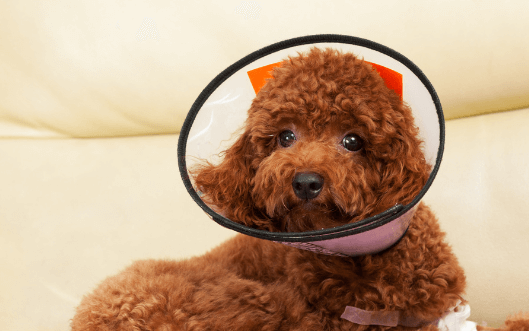Spaying A Female Cavapoo – When, How and Why

An important consideration for all dog owners is whether they should or should not spay their female Cavapoo puppy.
There are more pros than cons that you need to be aware of.
In this article, we will explore everything there is to know about spaying a female Cavapoo.
I will cover:
- Why it should be done at an early age
- Expected cost implications
- What to expect and how to prepare for the operation
- Recovery times associated with the procedure
- And more …
Read on for more information!
Spaying A Female Cavapoo – Why Should You?
The biggest advantage to having your Cavapoo spayed is linked to their health.
Health Advantages Of Spaying Your Dog
Studies have shown that spaying your dog greatly reduces its chances of getting cancer later in life.
For female dogs, this means the risk of getting mammary gland cancer is reduced to 1% and even less if she is spayed before her first heat cycle.
Other cancers like ovarian cancer can be completely avoided if the ovaries are removed when your dog is spayed.
Spaying will also prevent infections of the uterus in adult dogs which can be fatal.
An infection of the uterus is called ‘pyometra‘.
This infection is very serious, can make your dog extremely sick, and is deadly if not caught early enough.
A Vet might also recommend spaying your dog if she experiences false pregnancies or suffers from ovarian cysts.
Behavioral And Ethical Reasons To Spay Your Dog
Every day shelters are euthanizing perfectly healthy young dogs just because they have run out of room and no one wants them.
I am in no way saying you have to adopt a dog because let’s face it, we love Cavapoos and there are rarely Cavapoos in shelters!
What I am saying is, why would you breed your dog and add to this problem?
Don’t breed your dog just to experience having a litter.
Besides the amount of dogs needing homes, there is an ethical side to breeding dogs.
Reputable dedicated breeders put years of research and health testing behind their lines to produce the highest quality and healthiest pups that they can.
If you are not prepared to do the same then please don’t produce puppies that could end up with major health or temperament issues.
Just because your dog looks healthy and the Vet says it is healthy does not mean that it cannot pass on a deadly genetic disease to the pups.
Unless you have had specialized Veterinarians test for diseases like MVD (Mitral Valve Disease), SM (Syringomyelia), and CM (Chiari-like malformation) you cannot tell if your dog or the other parent dog is a carrier.
It is not fair to future owners as they will sit with the burden of enormous Vet bills and watch their Cavapoo deteriorate and suffer.
Spaying a female Cavapoo can help reduce aggression and other behavioral issues.
Cavapoos are not known to suffer from aggression but they can be excessively hyper and even moody at times.
Spaying can help to calm a dog down by reducing hormones that may be causing hyperactivity and moodiness.
Lastly, spaying your female Cavapoo will stop any male dogs trying their best to get to her to mate.
It is a nightmare keeping male dogs away and taking your dog for a walk is a huge challenge when your female Cavapoo is in heat.

When Should You Spay Your Cavapoo?
This is a contentious issue and owners can get very upset when talking about it.
You can ask 10 different Veterinarians and you will get a lot of different answers.
Some Veterinarians recommend waiting until your female Cavapoo has had her first season while others will insist on doing it after the second or third heat cycle.
Mostly though Veterinarians will recommend spaying a female dog before her first heat cycle.
At the end of the day, the decision is yours to make as you need to be comfortable with what you decide.
I can only give my opinion after 40-plus years of dog ownership, breeding, and a lifetime of experience.
In my opinion, the best age to spay your Cavapoo is between 6-9 months old when she has reached sexual maturity but before her first estrous cycle.
This helps minimize any risks associated with the procedure and provides maximum health benefits.
Additionally, spaying a female Cavapoo at a young age can greatly reduce her risk of developing mammary tumors and other reproductive cancers later on in life.
Pre-operation
It is perfectly normal to feel concerned and worried about your dog undergoing any surgery.
The best is to book an appointment with your trusted Veterinarian to discuss the operation and to answer any questions you might have.
You can also get their advice on when it should be done.
Take your dog with you so that she can be examined and the Vet can make sure there are no underlying health issues that could affect the surgery.
They might want to perform some tests such as drawing blood or doing x-rays if they feel it is needed.
Your Vet will explain that there is always a risk involved with any surgery. Just like with humans, things can go wrong but this is very rare.
However, you do need to be aware of this.
During this appointment, you can discuss which technique the Vet will be performing.
There are two basic types:
Traditional Spay – this is where both the ovaries and the uterus are removed.
The incision can be quite long and the recovery period can be longer but the advantage of this type of spay is that other issues like an umbilical hernia can be repaired at the same time.
Laparoscopic Spay – with this technique only the ovaries are removed.
The incision is a lot smaller allowing your dog to recover quicker.
However, this operation is more expensive than a traditional spay.
When she is cleared for the operation, then make sure you know the exact details of the operation (which technique they will be doing), how long it is expected to take, and who will perform it.
A very important question to ask is if you should withhold food and water before you take her in for the operation.
Most operations require your dog to fast beforehand to avoid them vomiting when under anesthesia.

Operation
This operation will be done under full anesthesia to ensure her comfort and safety.
During surgery, your veterinarian will closely monitor your pet’s vital signs, including respiration, heart rate, and oxygen levels in the blood.
Once she has been anesthetized, she will not feel any pain and remain unconscious until the procedure is complete.
They will also insert a breathing tube to administer oxygen during the operation.
An incision will be made just below the belly button and either the uterus and ovaries will be removed or just the ovaries depending on which technique you have decided on.
After the operation has been completed she will be moved to Recovery where she will be closely monitored and kept warm while the anesthesia wears off.
Post-operation
After a female Cavapoo has undergone surgery, she will likely be groggy and lethargic for a day or two.
So, don’t get a fright if she is still a bit confused when you pick her up.
This is perfectly normal.
It is important to keep her as comfortable as possible during this time.
The veterinarian might already have placed a cone over her head to stop her from licking the wound.
What I prefer and I think your dog will as well, is either a human baby onesie or a recovery surgical suit.
I prefer the recovery surgical suit as it is easier to put on and loosen for when she needs to go potty.
The suit will stop your dog from licking or tearing at the wound.
She might not want to eat the next day and this is fine.
Just keep offering her water to drink and she should bounce back within a day or so.
Speak to your veterinarian before you leave about when your Cavapoo needs to come back to have stitches removed (if they are not soluble) and for a checkup.

Recovery
- Keep your dog calm: I know it might seem impossible with some dogs but it is really important to keep her calm for at least 5-7 days. The last thing you want is for her to pull her stitches out or injure herself. Dedicate a separate quiet area of the house for her to stay in away from any boisterous children or loud noises. She should not have any physical activity until the Vet clears her to do so.
- Check for Infection: Check the incision site every day. If your dog seems to have a temperature or if the wound looks red then get hold of your Vet immediately. Keep the incision area dry at all times and never let it get wet.
- Pain Management: She will be sore for at least the first few days so your Vet may prescribe pain medication to help manage this. Follow whatever instructions your Vet has given you and don’t be afraid to give them a call if you are in any way concerned.
- Follow Ups: Take your dog back to the Vet to have stitches removed and to check on your pet’s recovery progress. During these visits make sure you ask them if they need to see her again and also when she can resume normal physical activities.
It is important to keep in close contact with your veterinarian throughout this process.
They are there to provide guidance and advice and should be consulted at every step.
Your dog’s health and well-being should be a top priority during recovery, so following all instructions is key to helping ensure a successful outcome.
What It Costs To Spay Your Dog
In the United States, the cost to spay a dog typically ranges from $50 to $250, depending on factors such as your geographic location, the weight of your dog, and whether you choose a low-cost clinic or a more expensive vet hospital.
The cost can also vary based on extra services like pre-surgical blood work or pain medications.
In the United Kingdom, spaying a dog will usually cost between £45 and £125 ($60 – $165) at most veterinary clinics.
The price can be higher if you opt for an emergency procedure after hours or out of normal opening times.
You may also need to factor in additional costs, such as pre-operative blood tests or post-operative antibiotics.
In some cases, the cost can be covered by insurance plans.
You should check with your Vet before making any arrangements.
Regardless of where you live, it is important to ensure your dog receives quality care when getting spayed.
Make sure your Vet is experienced and reputable, and always ask questions about their policies and procedures before booking a procedure.
It is also recommended that you get a second opinion from another vet if you have any doubts or concerns about the procedure.
The cost of spaying a dog should not be the only factor in determining which clinic to choose – ultimately, your pet’s health should come first.
Final Thoughts
No one likes putting their dog through an operation but spaying a female Cavapoo is the responsible thing to do.
The benefits of doing so may outweigh any negatives.
Your Cavapoo will become calmer, more affectionate, and not want to roam to find a mate.
Plus the win of not adding to the overpopulation of dogs makes this an important and necessary procedure.






